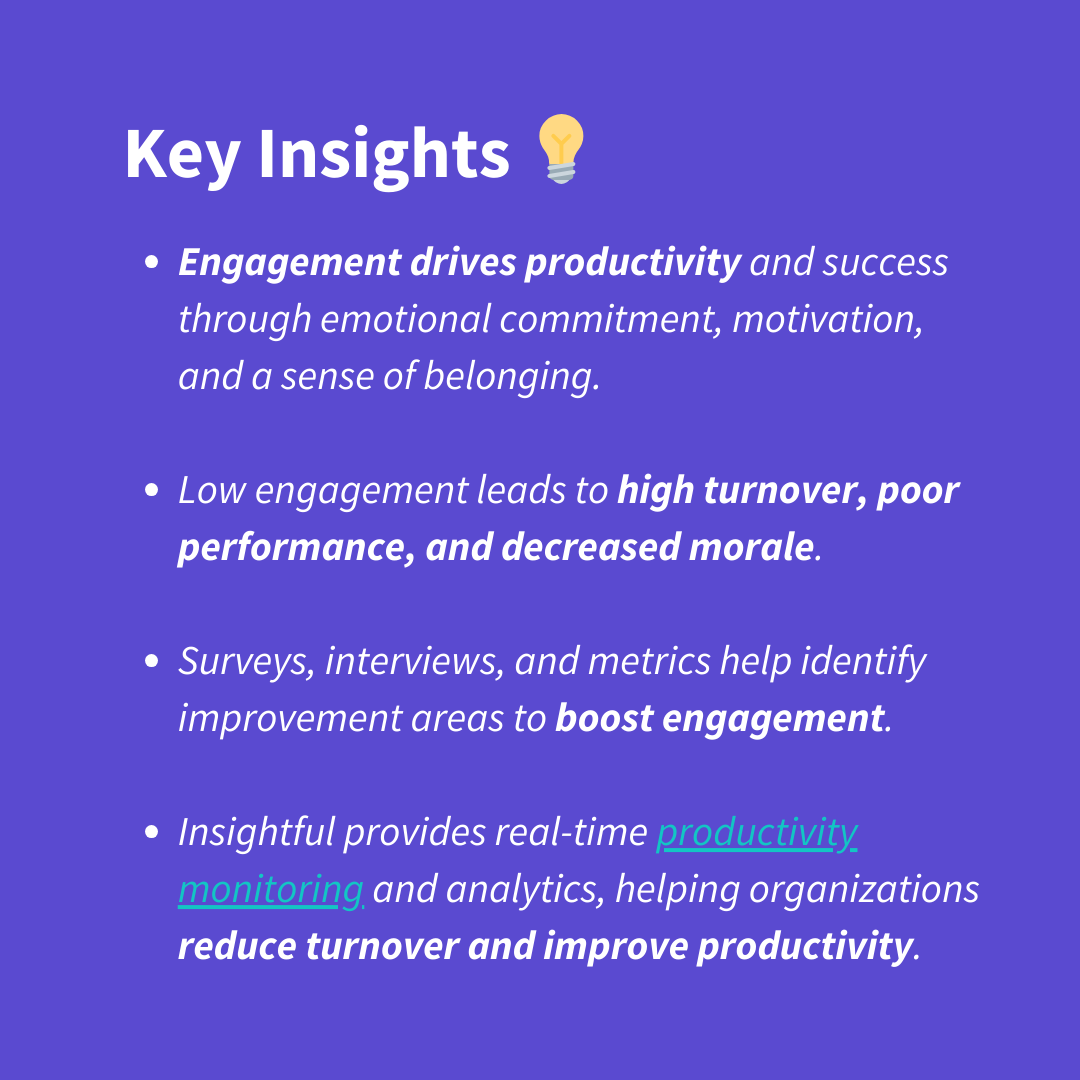The New Era of Employee Engagement: Transforming Workplaces for Success




Understanding Employee Engagement
The importance of employee engagement cannot be underestimated in today's organizations. It encompasses more than just job satisfaction, but also the enthusiasm, commitment, and personal investment that employees bring to their work environment.
While satisfaction may indicate contentment with the job's aspects like pay, work conditions, and benefits, engagement is a deeper emotional and psychological investment. An engaged employee is one who feels a compelling alignment with their organization's values and objectives, driving them to contribute effectively and proactively.
What are the key components of employee engagement?
- Emotional Commitment: This is the emotional attachment an employee feels towards their organization. It's the passion with which they approach their work and advocate for their company, often going above and beyond the call of duty.
- Motivation: Engaged employees exhibit a high level of motivation. They are driven not just by external rewards but by intrinsic factors like personal growth, fulfillment, and the desire to contribute meaningfully to the organization.
- Sense of Belonging: A crucial aspect of engagement is the sense of being an integral part of the organization. Employees who feel valued, understood, and connected to their colleagues and the company culture are more likely to be engaged.
Creating a workforce that is highly engaged has become a critical factor in building organizational resilience and promoting growth, especially in an environment characterized by swift transformations and fierce rivalry.
Organizations thrive when their employees are fully engaged and driven to innovate, not just committed to completing tasks. This level of passion and dedication is what fuels exceptional performance and sets successful companies apart from the rest.
Importance of Measuring Employee Engagement
Measuring employee engagement is not just a routine HR exercise; it is an essential strategy that significantly influences an organization's success and sustainability. The degree to which employees are engaged in their work has profound implications across various dimensions of an organization.
- Impact on Productivity and Organizational Success: Engagement is a powerful driver of productivity. Engaged employees tend to be more efficient, contribute more creatively, and demonstrate a higher quality of work. This enhanced productivity directly translates into better organizational performance and success, as engaged employees are more likely to achieve and surpass business goals.
- Role in Employee Retention and Turnover Rates: High levels of engagement are closely linked to employee retention. Employees who feel emotionally connected and valued by their organization are less likely to seek opportunities elsewhere. Conversely, low engagement levels often result in higher turnover rates, which can be costly for organizations in terms of recruitment expenses and the loss of talent and institutional knowledge.
- Influence on Workplace Morale and Culture: Employee engagement has a cascading effect on overall workplace morale and culture. A workforce that is engaged typically exhibits a more positive attitude, greater teamwork, and a collaborative spirit. This creates a vibrant and positive workplace culture, which in turn attracts and retains top talent. It also fosters an environment where continuous improvement and innovation are encouraged.
Methods of Measuring Employee Engagement
Understanding and measuring employee engagement is critical for any organization aiming to foster a productive and positive workplace. There are several methods to gauge this engagement, each offering unique insights and data:
Surveys:
Pulse Surveys: These are short, frequent surveys that provide quick insights into the current state of employee engagement. They are typically concise, focusing on specific issues or areas of interest. Their regularity allows organizations to track changes and trends over time, making them a valuable tool for ongoing engagement monitoring.
Annual Surveys: In contrast to pulse surveys, annual surveys are more comprehensive and are conducted once a year. They cover a wide range of topics, providing a deep dive into employee sentiments and engagement levels. While they offer extensive insights, their infrequent nature means they may not capture rapid changes or immediate feedback.
One-on-One Interviews:
Personal interviews with employees can uncover in-depth insights that surveys might miss. These discussions provide a safe space for employees to express their thoughts and feelings candidly. The qualitative data gathered from these interviews can reveal underlying issues and motivations affecting engagement.
Focus Groups:
Focus groups involve a moderated discussion with a group of employees. This method allows for a collective exploration of engagement issues, encouraging open dialogue and brainstorming. The dynamics of group discussion can often bring forth diverse perspectives and ideas that individual interviews or surveys may not capture.
Performance Metrics:
Analyzing various performance metrics can indicate levels of engagement. Metrics such as productivity rates, quality of work, and customer satisfaction scores can be correlated with engagement levels. High performance might indicate high engagement, while a decline in these metrics could signal disengagement.
Exit Interviews:
Conducting interviews with departing employees provides valuable insights into why employees leave the organization. These interviews can highlight aspects of the workplace or culture that may be contributing to disengagement and turnover. Understanding these reasons is crucial for organizations to address underlying issues and improve overall engagement.
Each of these methods offers distinct advantages and can be used in combination to provide a comprehensive understanding of employee engagement within an organization. Through the efficient utilization of these resources, companies can pinpoint problem areas, devise specific tactics to improve involvement, and ultimately establish a more dedicated and contented staff.
Best Practices for Conducting Employee Engagement Surveys
Conducting employee engagement surveys is crucial for evaluating and enhancing the workplace atmosphere. To achieve the best results, it's important to follow specific guidelines and practices.
Frequency:
It is important to establish the optimal frequency of surveys each year. While frequent surveys, such as quarterly or even monthly pulse surveys, can provide ongoing insights, it's important to balance this with potential survey fatigue. An annual survey, complemented by more frequent pulse surveys, often strikes a good balance, allowing for timely feedback without overwhelming employees.
Length and Content:
To encourage participation, it is important to keep surveys brief and to the point. Lengthy surveys can be overwhelming and may result in incomplete responses or disinterest in the survey process. The content of the survey should be relevant and focused on specific aspects of employee engagement that are important to both the organization and its employees. This will ensure that the data collected is useful and can be acted upon.
Anonymity and Confidentiality:
To encourage honest and candid feedback, surveys should be anonymous and confidential. Employees must feel safe to express their true feelings without fear of repercussions. This assurance of anonymity leads to more accurate data and insights into the actual state of employee engagement.
Including Open-Ended Questions:
While quantitative data is valuable, qualitative insights are equally important. Including open-ended questions in surveys allows employees to provide more detailed feedback and share their thoughts and suggestions in their own words. These responses can uncover nuances and deeper insights that closed-ended questions might miss.
Here are some examples:
"What is your perception of the management and leadership in our company? How do they support you in your role, and what could be done better?"
"What motivates you the most in your current role, and what factors do you feel could enhance your engagement with your work?"
"Do you feel you have the opportunity to be innovative and creative in your role? Please provide examples or suggestions for improvement."
"How do you feel about the recognition and rewards system in the company? What changes would make it more impactful for you?"
"Where do you see yourself in the organization in the next few years? What support or changes would help you achieve your career goals?"
To promote an environment of transparent communication and ongoing progress, companies can implement optimal methods for creating and administering staff engagement assessments that effectively collect pertinent information. These surveys become a valuable resource for understanding and enhancing the employee experience, leading to a more engaged and productive workforce.
Implementing Changes Based on Feedback
For any organization, it is essential to act upon the feedback obtained from employee engagement surveys. It demonstrates to employees that their opinions are valued and taken seriously, which in turn can boost morale and further engagement. Ignoring feedback can lead to disillusionment and decreased productivity, whereas acting on survey results shows a commitment to continuous improvement and employee well-being.
Strategies for Addressing Common Areas of Concern
- Communication and Transparency: If feedback indicates a lack of effective communication, organizations should strive to create more open channels of communication. Regular updates about company decisions and open forums for discussion can be beneficial.
- Recognition and Reward Systems: For concerns related to recognition, companies can implement more frequent and varied forms of employee appreciation. This could range from formal award systems to informal acknowledgments of achievements.
- Professional Development: Addressing concerns about growth and development opportunities can involve offering more training programs, educational resources, and clear pathways for career advancement.
- Work-Life Balance: If employees express concerns about work-life balance, organizations could consider flexible working arrangements, such as remote work options or flexible hours.
- Management Training: Feedback regarding management practices can lead to targeted training programs for managers, focusing on leadership, empathy, and effective team management.
Monitoring Improvements and Ongoing Engagement
- Follow-Up Surveys: Conducting follow-up surveys can help organizations gauge the effectiveness of the changes implemented and understand ongoing employee sentiments.
- Continuous Feedback Mechanisms: Establishing mechanisms such as suggestion boxes or regular meetings where employees can continuously provide feedback ensures ongoing dialogue.
- Performance Metrics: Monitoring changes in performance metrics can provide quantitative data on the impact of the changes implemented. Increases in productivity, efficiency, or customer satisfaction can be indicative of successful engagement strategies.
- Employee Retention and Turnover Rates: Keeping track of retention and turnover rates can also serve as an indicator of the workplace environment and employee satisfaction.
Creating a workplace that is dynamic and responsive requires implementing changes based on employee feedback and consistently monitoring them. This not only resolves current issues but also cultivates a culture of ongoing improvement and employee involvement.
Enhancing Employee Engagement with Insightful
As organizations strive to foster a vibrant and engaging work environment, the role of comprehensive monitoring tools like Insightful becomes increasingly significant. Insightful’s PC monitoring software is a robust platform that aligns seamlessly with the various aspects of measuring and enhancing employee engagement, ensuring a proactive approach to workforce management.
Enhanced Engagement Understanding: With features like Engagement Levels, Insightful provides a nuanced understanding of employee engagement, measuring active involvement through keyboard and mouse usage. This data, coupled with insights from traditional surveys and interviews, offers a more complete picture of engagement across the organization.
Streamlined Integration with Management Tools: Insightful’s integration capabilities, especially with project management tools like Jira and Basecamp, enable streamlined workflow management. This integration aids in tracking performance metrics and aligns with the quantitative aspects of engagement measurement, enhancing the effectiveness of strategic decision-making.
Proactive Alert Systems for Engagement and Security: The platform’s alert system offers real-time notifications, which are crucial for maintaining attendance, security, and overall efficiency. These alerts also play a role in identifying engagement dips and potential security issues, allowing for timely interventions.
Real-Time Monitoring for Immediate Insights: Insightful’s real-time monitoring and activity tracking features provide immediate insights into employee productivity and behavior. This continuous monitoring helps identify trends and patterns, contributing to a dynamic understanding of engagement levels.
Customizable and Comprehensive Reporting: The platform’s comprehensive reporting capabilities ensure that managers and HR professionals have access to detailed data on engagement trends. Customizable settings allow for tailored analysis, aligning with specific organizational needs and objectives.
Insightful's productivity tracker effectively solves the issue of how to track remote employees, but Insightful is more than just a monitoring tool; it is a key enabler in the journey towards creating a more engaged, dynamic, and successful organizational environment. Its role in supplementing traditional engagement measurement methods with real-time data and actionable insights marks it as an invaluable asset for any forward-thinking organization.
Updated on May 9th, 2024

.jpg)
.jpg)
